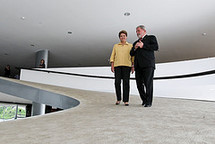Tuesday, April 16, 2024
News and Views from the Global South
Brazil’s President-Elect Brings Gender to Government
Fabiana Frayssinet
- In a move seen as a sign that gender will be important in her government, Brazil’s president-elect Dilma Rousseff is preparing a Cabinet that is one-third women.

Rousseff and Lula in the middle of the transition, together at the Planalto presidential palace. Credit: Presidenta Dilma
The president-elect served as a government minister herself and has been among Lula’s leading collaborators in his eight years in the presidency. Both belong to the Workers Party (Partido dos Trabalhadores, PT).
“It would be a very important gesture that the first-ever woman president concerns herself with women’s matters,” Teresa Sacchet, of the public policy research centre at the University of São Paulo, told IPS.
“I have hopes that the government will make a leap in regards to gender, that it will show more concern about gender inequality and others, like social inequality,” she added.
Of Lula’s 24 ministers, just three are women, although his two terms in office are seen as having advanced laws and policies that promote gender equality.
However, women were the stars of the October elections, and not just because they make up 51.7 percent of the electorate. In the first round of presidential voting, on Oct. 3, two women candidates came in first and third place: Rousseff with 47 percent of the votes, and Marina Silva, of the Green Party, with nearly 20 percent.
That is why Sacchet, who holds a doctorate in political science from Britain’s University of Essex, believes that if one-third of Rousseff’s ministers are women, “it would have great symbolic importance” because, among other things, it will encourage more women to participate in politics.
“The move by Dilma (as everyone in Brazil refers to their president-elect) to put women in the ministries is very important because Brazil is lagging behind in terms of women’s participation in politics and in the arenas of power,” stated Beatriz Galli, of IPAS Brazil, an organisation that promotes women’s reproductive health and rights, as well as women’s participation in power — both in the public and private sectors.
“Gender equality has to begin with women’s participation at the highest ranks of government,” the IPAS consultant told IPS.
The trouble, according to the local news media, is that the transition team is having a hard time finding women to fill one-third of the Cabinet posts.
Many of the women contacted for the ministry positions are lawmakers and the parties of the governing coalition don’t want them to give up their seats because it would weaken their presence in the bicameral Congress.
But the true roots of the problem begin with the political parties themselves. Brazil’s electoral law requires a gender quota of 30 percent among the candidates the parties put up for election, but that portion is a long way from being met — though some advances have been made in the last 15 years.
In 1994, before the implementation of the quota, Sacchet recalls that women represented 6.4 percent of the candidates for deputy posts in the national Congress, and 7.3 percent for the state chambers. In October, the figures were 12.9 percent and 14.5 percent, respectively.
That is a greater gender gap than is found in the other two Latin American countries that currently have women presidents.
In Costa Rica, women hold 38.6 percent of the congressional seats, and in Argentina, 38.5 percent, which ranks them 11 and 12 in the world for women’s parliamentary representation, according to the Inter-Parliamentary Union. Brazil is ranked 106, out of 136 countries.
The party leaders say they face difficulties in meeting the quota, which in the case of Brazil is practically voluntary. Among the challenges they cite is the lack of women who are active in politics.
But Sacchet has researched the matter and has come up with other explanations. She believes the low numbers are due to institutional and political obstacles that make it difficult for women to participate on equal footing with men — and not gender bias among the electorate.
First of all, says the researcher, the party structure itself makes access for women difficult. Some parties argued, for example, that the times their meetings are scheduled tend to preclude women’s participation.
Secondly, the women candidates usually don’t have political support of the “party machine,” or its financial backing. Sacchet’s study indicates that women’s electoral campaigns spend 40 percent less than men’s, and “in Brazil there is a close correlation between electoral spending and the chance for victory.”
“Because women have fewer financial options, it’s more difficult for them to get re-elected. If they aren’t given real opportunities to participate in equal conditions with the men, it will be difficult for women to get elected and to proportionally increase the elected posts held by women,” she said.
The political scientist believes a change in Brazil’s electoral system could provide solutions with a gender perspective.
Brazil currently has a system of proportional representation with open lists of candidates, which Sacchet says has several inherent problems. “It favours the individualisation of the campaigns and exacerbates financial expenditures amongst candidates,” who end up competing with members of their own parties, she said.
She pointed out that women have a better chance in Argentina, where the system is based on a closed list. Furthermore, if Argentina’s political parties fail to comply with gender quotas on their lists, they face sanctions.
The problem in Brazil can be illustrated by comparing the results from October’s election and the election four years ago, according to Sacchet.
In 2006, 13 percent of the legislative candidates were women, and in 2010 the portion rose to 22 percent. But that was not reflected in the results. “Despite having nearly twice as many women candidates than in 2006, in this new legislature we lost a woman,” she said.
The outgoing Brazilian Congress has 45 women deputies, and the new one will have 44.

 Print
Print



